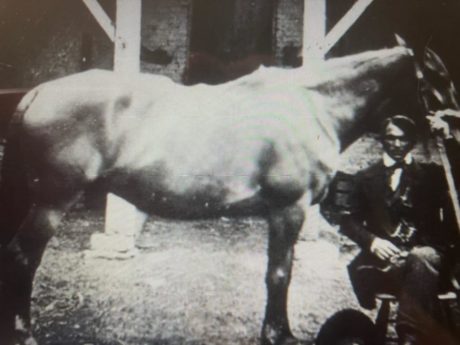Glenalvin Goodridge, 1829-1867; teacher, iconic photographer
Goodridge and Grey Family: Extraordinary Abilities and Service While Enduring Racial, Economic, and Judicial Injustice
By SUE HUNTER WEIR
from Tales from Pioneers and Soldiers Memorial Cemetery

It’s taken more than a century and a-half but Glenalvin Goodridge is finally getting his due. Although he was well-known and highly regarded during his lifetime, he died in 1867, and other than a handful of scholars, few people have heard of him. That has changed since his work is now part of an important exhibit at the Smithsonian American Art Museum in Washington D.C.
Glenalvin is acknowledged to be one of the country’s pioneering Black photographers. He began his career as a photographer in 1847, when he was only 18 years old. In addition to his extraordinary artistic talent, he followed in the footsteps of his father William Goodridge, one of the most successful entrepreneurs in York, Pennsylvania. William was a successful businessman, but he is best known today for his role in conducting the Underground Railroad between York and Philadelphia. Their home in York is listed in the National Register of Historic Places and serves as the Goodridge Freedom Center and Underground Railroad Museum.
In the early days of his career, Glenalvin earned additional income by teaching at a segregated school for Black students in York. He won numerous prizes for his daguerreotypes* and his success enabled him to charge considerably more for his work than his competitors. He married Rhoda Grey in 1851, and the couple eventually had four children.
His career was tragically cut short when he was accused of rape. Court trial witnesses testified that the accuser had claimed that she knew that the Goodridges were wealthy and that she could benefit from that. Despite the fact that the charges against him were thought by many as an attempt by his accuser to extort money from the family; nonetheless, Glenalvin was found guilty and was sentenced to five years in prison. His father mounted a vigorous campaign to have the governor pardon his son. He enlisted the help of several influential friends, many of whom expressed the opinion that if Glenalvin had been white, he would not have been convicted. After he had spent twenty-one months in prison, Glenalvin was finally pardoned. One of the conditions of his release was that he had to leave Pennsylvania so he moved his family to Saginaw, Michigan where his two younger brothers, Wallace and William, and their sister Mary were living. William and Wallace were operating the Goodridge Brothers Photographic Studio which won international awards for, among other things, their photographic record of the white pine lumbering industry.
During Glenalvin’s stay in prison, he is thought to have contracted tuberculosis although there is some speculation that he, like several other early photographers, became ill from the chemicals that they used to process photos. He had entered prison in good physical condition but less than two years later, his physical condition was downgraded to “delicate.”
In 1865, his father was living in Minneapolis with his daughter Emily and her husband Ralph Grey. William traveled to Saginaw and brought Glenalvin back to Minneapolis with him. One theory is that Glenalvin wanted to buy a life insurance policy to provide for his wife and children. In order to do that he needed to prove that he was capable of doing physical labor (which he wasn’t) or that he was able to travel. Glenalvin died on March 15, 1867; the cause of death in the Cemetery’s records is “consumption”.
Although his imprisonment and poor health cut short Gleanalvin’s career, it does not diminish his importance as an artist and successful businessman and one of the earliest and most important pioneers in his field. The Goodridge Brothers Photographic Studio continued operating in Saginaw until 1922 making it the longest-running Black-owned photography business in the United States.
Glenalvin is buried next to his father and his nephew Toussaint L’Ouverture Grey. Toussaint, the son of Ralph and Emily Grey, was named after Toussaint L’Ouverture who led the fight for Haitian independence from the French. Toussaint Grey died on June 28, 1863, at the age of nine from a congenital heart defect. He was the first Black child born in St. Anthony. His parents were political activists who played a key role in a court case involving a woman named Eliza Winston who sued her enslavers for her freedom. She won.
William Goodridge died in Minneapolis on January 1, 1873, from “dropsy,” most likely congestive heart failure. He was 70 years old. Their graves are located in Lot 28, Block K.
For more information about Glenalvin Goodridge and the Goodridge family, check out “Enterprising Images,” by John Vincent Jezierski which is available through the Hennepin County Library. The library only has one copy and used copies are expensive but the book is available for free on Google Books. There are also numerous articles and stories about the Goodridges on the internet. Also at alleynews.org/archives/February 2021.
*Daguerreotype is a unique image on a silvered copper plate that is accurate, detailed, sharp on a mirror-like surface that is inflexible, heavy and very fragile in contrast to photographic paper.
Sue Hunter Weir is chair of Friends of the Cemetery, an organization dedicated to preserving and maintaining Minneapolis Pioneers and Soldiers Cemetery. She has lived in Phillips for almost 50 years and loves living in such a historic community.









